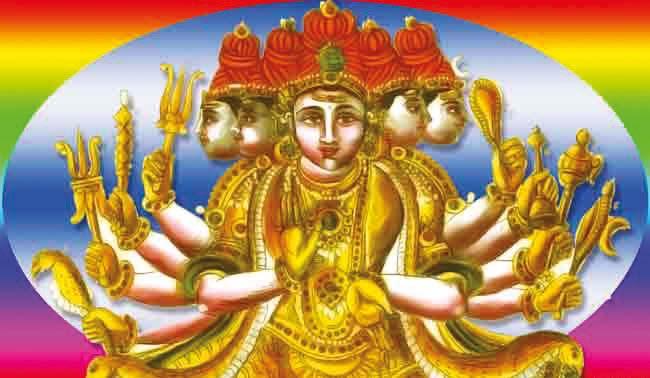
Normally Lord Shiva is worshipped as Shiva Linga. Shivalingas with five faces are also found in some places. The Names of the five faces are:
Sadyojat, Vamdev, Aghoraa, Tatpurush and Îshana
These four faces of Shiva represent the four directions. The fifth face which points skywards is the universal face symbolic of purity and spiritual progress.
This rare prayer in each stanza addresses each one of these five faces of Shiva, the 4 Vedas and Om.
Comparable to the Vyuhas or emanations of Lord Visnu, is the Pancanana form of Lord Siva. Pancanana or the five-faced one represents the five aspects of Shiva vis-a-vis the created universe. The five faces are respectively Hana, Tatpurusa, Aghora, Vamadeva and Sadyojata. The face Hana turned towards the zenith, represents the highest aspect and is also called Sadasiva. On the physical plane, it represents the power that rules over ether or sky and on the spiritual plane, it is the deity that grants Moksa or liberation. Tatpurusa facing east, stands for the power that rules over air and represents the forces of darkness and obscuration on the spiritual plane. Aghora, facing south and ruling over the element fire, stands for the power that absorbs and renovates the universe. Vamadeva facing north, ruling over the element water, is responsible for preservation. Sadyojata, facing west represents the power that creates.
Iconographically, all the five aspects are shown in different ways.
There are several other aspects in which Lord Siva is depicted or worshipped. These can be broadly divided into the following categories: (1) Saumya or Anugraha Murti; (2) Ugra, Raudra or Samhara Murtis; (3) Nrtta or Tandava Murti;(4) Daksinamurti; (5) Lingodbhavamurti; (6) Bhiksatanamurti; (7) Haryardhamurti; (8) Ardhanarisvaramurti.
Peaceful form of Siva as also the form showing mercy and grace belong to the first group. The forms showing grace or granting boons to Candesa, Nandisvara, Vighnesvara or Ravana belong to this category.
All terrific aspects can be classed under the second group. Kankala Bhairava represents Siva who cut off the fifth head of Brahma for having reviled him and who had to wander as a beggar for twelve years to get rid of that sin. Gajasuravadhamurti represents him as killing the demon Nila (an associate of Andhakasura) who had assumed the form of an elephant. Tripurantaka-murti depicts him as destroying by his arrow, the three cities of iron, silver and gold built on the earth, in air and in heaven by the three sons of Andhakasura who had become almost invincible because of these three impregnable shelters. Sarabhesamurti pictures Siva as a Sarabha (an imaginary animal more ferocious than the lion) destroying the Narasirhha form of Visnu, a story obviously conceived by the Saivites to assert the superiority of their Lord over Visnu! Kalari-murti portrays him as vanquishing Yama, the god of death, who wanted to take away the life of Markandeya, a great devotee of Siva. Kamantakamurti illustrates him as destroying Kama, the god of lust, by the fire emitted through his third eye. Andhakasura-vadha-murti shows him as vanquishing Andhakasura and later on, on supplication, conferring on him the commandership of the Gal)as (dwarf attendants). Andhaka became Bhrngisa.
Lord Siva is a great master of dance. All the 108 modes of dancing known to the treatises on dancing have come from him. It is said that he dances every evening in order to relieve the sufferings of creatures and entertain the gods who gather in Kailasa in full strength. (Hence he is called Sabhapati, the lord of the congregation.)
Only nine modes of dancing are described of which the Nataraja aspect is the most well-known. The Nataraja icon shows him with four hands and two legs, in the posture of dancing. There is the Damaru (drum) in the upper right hand and fire in the left. The lower right hand is in Abhayamudra (pose of protection) and the left is pointing towards the uplifted left foot. The left foot is resting on the demon Apasmarapurusa. The whole image mayor may not be surrounded by a circle of blazing fire.
Siva’s dance indicates a continuous process of creation, preservation and destruction. The Damaru represents the principle of Sabda (sound) and hence Akasa (ether), which proceeds immediately from the Atman and is responsible for further creation or evolution. Fire represents Pralayagni, the fire that destroys the world at the time of dissolution of the world, and hence symbolises the process of destruction. Thus damaru and fire represent the continuous cycle of creation, preservation and destruction. The other two hands indicate that he who takes refuge at the feet of the Lord will have nothing to fear. The Apasmara-purusa (Apasmara=epilepsy) symbolises ignorance which makes us lose our balance and consciousness. He is trampled upon by the Lord for the good of the devotees who take refuge.





Here are some interesting reads of faces of Shiva about which your blog talks … These are how these were seen during meditation ….
Aghora face of Sadashiva … https://www.makersmakings.org/aghora-face-of-sadashiva/ … This has the endless sound of Ahum (this is heads as an endless condition of Aaaaaaa…Hum…Aaaaaaaa…Hum…)
Tatpurusha face of Sadashiva … https://www.makersmakings.org/tatpurusha-face-of-sadashiva/ … This has the endless sound of O as shown in this link … https://www.makersmakings.org/okar-sound-of-o/ … This is Okar or Ukar of Yoga and it also is addressed Hiranyagarbha in Vedas …
Vamadeva face of Sadashiva … This is Vaikunth …
https://www.makersmakings.org/vamadeva-face-of-sadashiva-vaikunth/
Sadyojata face of Sadashiva … This is Brahmaloka … m
https://www.makersmakings.org/sadyojata-face-of-sadashiva-brahmaloka/
…
Pshana face of Sadashiva is what Sadashiva means … Here is a description of Pancha Mukha Sadashiva. ….
https://www.makersmakings.org/pancha-mukha-sadashiva/